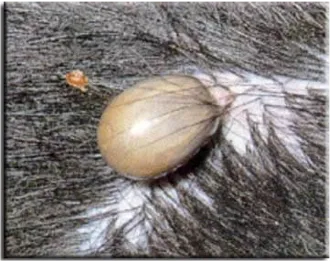Dog from abroad
If your dog has lived abroad for a while, there are a number of diseases that your dog can have without you noticing. Diseases that do not occur (frequently) in the Netherlands and who can sometimes only cause serious complaints after years.
Dogs that have been brought in from abroad by a foundation are usually declared healthy. Often a blood test is done for the diseases mentioned below. Unfortunately, these tests are often false negative and will be positive after a few months. We therefore find it important to test your animal for a number of diseases that may be present but have not (yet) caused any disease.
Diseases that we test for
We test for Heartworm, Lungworm, Leishmania and Erhlichia. Later in this letter you will find information about other (tick) diseases (Babesia, Lyme, Anaplasma and Hepatozoon) that can make your dog ill, but which we do not routinely test for because this has not been shown to be useful.
Heartworm (dirofilaria immitis)
Heartworm is a worm that occurs in dogs and cats and mainly lives in the pulmonary arteries (usually not in the heart).
In addition to lung problems, it can also cause serious heart problems. The heartworm produces microfilaries that are sucked up by a mosquito and a next stage of the parasite is passed on to the next victim. It takes about 6 months for such a mosquito-transmitted larva to become an adult worm.
Heartworm has become an increasing problem in Europe over the last 10 years. The heartworm cannot yet develop further in the mosquito in our climate, but it is expected that this will happen due to global warming.
Humans can sporadically act as an improper host, where the parasite’s life cycle is not completed. The larvae can cause subcutaneous damage and sometimes eye damage and can encapsulate in the lungs where they eventually calcify. The risk in humans is then mainly the chance of confusion with lung tumors, resulting in unnecessary treatments and sometimes even operations.
A blood test only becomes positive 6-8 months after infection. The worms are then already adults and can already cause clinical problems.
Heartworm occurs in the dark red colored areas.

Lungworm (angiostrongylus)
Also called French heartworm, it only occurs in dogs and is usually not in the heart but in the lungs. The adult worms lay eggs, from which a larva emerges, which is coughed up and excreted in the feces. A snail ingests the larva and the dog eats the snail or snail slime. After 40-60 days an adult worm develops again, with which the cycle is complete again.
The worm causes lung problems (shortness of breath, coughing) and heart problems (big belly, fainting, reduced stamina). Furthermore, it can cause clotting disorders and, due to bleeding, also neurological symptoms such as paralysis, strange behavior and reduced consciousness. We can test whether your dog has lungworm by examining the stool of 3 consecutive days or, just like with heartworm, through a blood test. Monthly deworming is also highly recommended.
This worm also occurs in the Netherlands:
- The Hague region
- North Veluwe
- Flevoland
- Wassenaar
- North Holland
Leishmania
This parasite is transmitted by sand flies. After a few months or even several years, skin complaints, kidney problems and poor condition can occur. The disease is treatable but not curable and we therefore only treat if the dog is showing symptoms of disease. A positive test alone is therefore not enough reason to start treatment, but it’s good to know whether your animal is infected so that we know which symptoms to watch out for in the future. It can take more than a year for an infected dog to become seropositive. A biopsy of the lymph nodes and/or bone marrow often tests positive sooner. A dog that has tested negative for Leishmania in the country of origin can unfortunately still test positive later (in the Netherlands). Just like heart and lung worms, we can also test for Leishmania through a blood test.
Ehrlichiosis
Dogs infected with Ehrlichia Canis often become acutely ill and have a high fever. This is called acute Ehrlichiosis (Carpathian disease). With proper treatment, many of these animals will recover. With a blood test, these dogs will test positive. Unfortunately, these animals can become ill again up to more than 7 years later. This is called chronic Ehrlichiosis.
Rhipicephalus sanguineus (the tick that transmits Ehrlichia and Babesia) is mainly a Southern European tick (common below the red line in the image below). Dogs can live with Ehrlichia for years without you noticing. If clinical signs appear, a dog with chronic Ehrlichiosis can suddenly become seriously ill.

Diseases that we don’t test for
There are also a number of parasitic diseases that we don’t test for because this is not useful, such as Lyme, Anaplasma, Babesia and Hepatozoon. Below you can read what these diseases are about.
Lyme
Many dogs have antibodies against Lyme disease in the blood. Some sick and many healthy dogs test positive for this. When dogs are injected with the Lyme bacteria, they usually do not get sick. Lyme disease has been seen in infected dogs, however, this can be treated with antibiotics. Prevention against ticks is recommended but a blood test is not useful.

Anaplasma
Anaplasma is transmitted by the same tick as Lyme disease. The parasite has also been found in Dutch ticks. A tick must suck blood for 24 to 48 hours before transmitting the Anaplasma pathogen. A dog becomes ill 1-2 weeks after infection. The prognosis is good after treatment.
Anaplasma phagocytophilum occurs in Western Europe, so also in the Netherlands. Dogs that test positive for Lyme disease may also have Anaplasma.
Anaplasma platys occurs in Southern Europe. The patient may be simultaneously infected with Babesia and/or Ehrlichia canis.
Symptoms Anaplasma:
- Acute lethargy
- Loss of appetite
- A fever
- Lameness (joint inflammation, polyarthritis)
- Pale mucous membranes
- Vomiting/diarrhea
- Skin bleeding
- Shortness of breath
- Enlarged lymph nodes/spleen
- Rare: cough, inflammation of the eyes, swelling of the legs, drinking a lot and neurological signs
We get the diagnosis Anaplasma through a blood test. 1 to 4 weeks after exposure, dogs become seropositive: The body has produced antibodies against the parasite, the dog then remains seropositive. If we find the antibodies in the blood, we prove that the dog has had Anaplasma at some point in life, but it does not prove that the Anaplasma is the reason for the current complaints. Preventive testing for Anaplasma is therefore not useful, but tick prevention is!
Babesiosis
Babesiosis is the disease caused by the blood parasite Babesia. The parasite is transmitted by ticks that live in warmer countries. 1-3 weeks after infection, the infected dog develops a fever, anemia and red/brown urine. Some dogs don’t get sick until months later.
Babesiosis is treatable. If left untreated, animals can die from the disease. Babesia is a parasite of the red blood cell and multiplies there. If the red blood cell is destroyed as a result, the parasite infects the next red blood cell. Due to the destruction of the red blood cells (1-3 weeks after the tick bite), the dog becomes very ill.
Symptoms Babesiosis:
- A fever
- Jaundice
- Vomiting
- Red urine
- Anemia
- Kidney failure
Sometimes the disease becomes chronic and then we also see muscle and joint inflammation and recurrent fever. The parasite is transmitted by the same tick as Ehrlichia.
Hepatozoon
Hepatozoon is a unicellular parasite (protozoa) that can make dogs sick. The parasite occurs in the southern countries of Europe. In the Netherlands we only see it in dogs that have been in one of these countries. The dog can become infected by eating an infected tick. The dog licks/bites the fur and thus ingests the tick.
Hepatozoon is not a big problem, we rarely encounter the disease, even in dogs that have been on holiday to the Mediterranean.